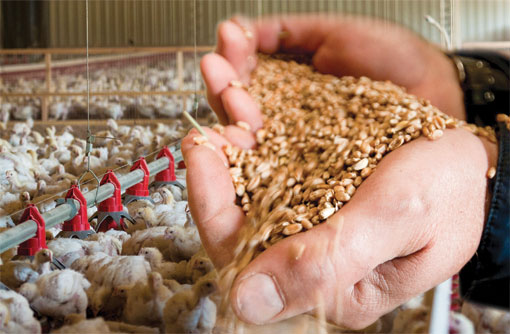30
Apr
Animal Fodder – A Driver of the Global Highly Hazardous Pesticides (HHPs) Industry
(Beyond Pesticides, April 30, 2020) Chemical-intensive farming of crops for animal fodder powers the global market for highly hazardous pesticides (HHPs), according to data analyzed by Unearthed, and the Swiss NGO Public Eye. Animal fodder production not only intensifies global pollution, but it also increases pesticide exposure and degrades human, animal, and environmental health. This data analysis supports advocates advancing pesticide policies to eliminate HHPs by identifying which toxic chemicals lead global pesticide sales. However, it will take more than eliminating the worst chemicals to address the impending biodiversity collapse and the climate crisis, according to experts who point to the need for an urgent shift to organic land and agricultural management practices. United Nations’ (UN) special rapporteur on toxic substances and human rights, Baskut Tuncak, says, “There is nothing sustainable about the widespread use of highly hazardous pesticides for agriculture. Whether they poison workers, extinguish biodiversity, persist in the environment, or accumulate in a mother’s breast milk, these are unsustainable, cannot be used safely, and should have been phased out of use long ago.”
Unearthed and Public Eye investigated over $23 billion in global pesticide market sales to determine the proportion of pesticides considered highly hazardous by the Pesticide Action Network’s (PAN) International 2019 list of HHPs. HHP hazard categories include acutely toxic, chronic health hazards, environmental hazards, and toxic to bees. Data analyzers obtained global market sales information from the leading agribusiness intelligence firm, Phillips McDougall. Top-selling pesticide products were in the pesticide industry’s most valuable “market segments” (e.g., “herbicides for soya in the US”). Analysts compared global HHP sales data in 12 staple crop groups to determine which crops provided the largest market for major pesticide manufacturers.
Highly hazardous pesticides amassed $9.9 billion in global sales with maize (corn), soybean (soy), cereal, cotton, and rice accounting for over $4 out of every $5 spent on HHPs. The investigation identified 19 chemicals as premier selling HHPs. Glyphosate was the most commonly sprayed HHP across all five crops. Atrazine and epoxiconazole were HHPs present in grain crops like rice and cereals, respectively. Over 69% of pesticide sales for cotton crops were HHPs, 44% of which were toxic to bees. Although nearly half of all global HHP spraying was on soybean and maize, staple crops in animal fodder, soybean provided the biggest market for HPPs by value.
Land use data displays ~50% of all global habitable land as agricultural, with over 75% of all farmland supporting livestock fodder and grazing. Agricultural land is subject to chemical-intensive farming, and many fodder crops (i.e., corn and soy) use HHPs to manage pests. Globally, farmers use glyphosate to manage corn and soy crops more than any other HHPs. However, 93% and 85% of soy and corn, respectively, are genetically engineered (GE) to tolerate glyphosate. Glyphosate-resistant crops increase herbicide use, enhance herbicide-resistant weeds (i.e., superweeds), and cause health and environmental harms. Multiple studies indicate glyphosate’s carcinogenic effects in humans, as well as adverse impacts on ecosystem biodiversity, pollinators, foraging/brooding habitats, and pest / bacterial resistance. Most corn and soy crops are monocultures, wherein demands for fodder exceed requests for diverse crop production. Perversely, monoculture crops induce biodiversity loss and pollinator decline via pesticide exposure and habitat destruction.
The data indicates which crops represent the largest markets for major pesticide manufacturers. North American soybean crops provide the largest market for all pesticides, but analysts project South America to dominate soy production in 2020. Already, over 50% of all HPP sales for soybean crops go to Brazilian soy fields. Brazilian farmers spend large amounts on HHP to overturn vast amounts of land for soy monocultures, according to Larissa Bombardi, Ph.D., professor of geography at the University of Sao Paulo. Additionally, over 90% of developing soy crops are GE for glyphosate-resistance. An increase in Brazilian soybean monocultures, GE soy crops, and intensive HHP use present health and environment threats, including threats to local food security. Dr. Bombardi mentions, “In addition to driving deforestation and increased use of pesticides, this [HHP] industry was also having ‘an impact on food security.’ …Brazil [saw] a reduction in the amount of land planted with ‘the four crops that are the basis of national food:’ wheat, cassava, rice, and beans.”
Chemical-intensive farming contributes to HHP global market sales as farmers apply various herbicides and insecticides to many staple fodder crops. International sales of HHPs pose a serious global health risk as 18 out of 19 analyzed HHPs are available in the U.S. pesticide market for use. Most Americans want stricter oversight of general large-scale livestock operations. The analyzed data can provide global implications for pesticide management surrounding agriculture while supporting oversight restriction and elimination of HHP-treated fodder. Organic agriculture has many health and environmental benefits, which curtail the need for HHPs. Regenerative agriculture revitalizes soil health through organic carbon sequestration while reducing pests and generating higher profits than chemical-intensive agriculture. Learn more about the adverse health and environmental effects chemical-intensive farming poses for various crops and how eating organic produce reduces pesticide exposure.
See Beyond Pesticides webpage on organic agriculture.
All unattributed positions and opinions in this piece are those of Beyond Pesticides.
Source: Unearthed












Really great read!! This article contained a lot of statistics I was unaware of. I would truly love to learn more about the use of organic pesticides on a global scale!
April 30th, 2020 at 9:59 am